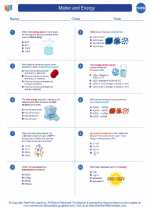Matter and Energy -> filtration
Components of Filtration
- Filter medium: This is the material through which the mixture is passed. It may be a porous material, such as filter paper, or a physical barrier, such as a mesh screen.
- Filtrate: The liquid that passes through the filter medium and is collected below it.
- Residue: The solid particles that are retained by the filter medium and collected on top of it.
- Filtration apparatus: This includes a funnel, filter paper, and a container to collect the filtrate.
Steps in Filtration
- Place the filter medium (e.g., filter paper) in a funnel, and set the funnel in a container to collect the filtrate.
- Pour the mixture to be filtered into the filter paper. The liquid will pass through the filter paper, leaving the solid particles behind.
- Collect the filtrate in the container below the filter paper.
- Remove the residue from the filter paper and dry or further process it if needed.
Applications of Filtration
Filtration is widely used in various fields, including:
Study Guide for Filtration
When studying filtration, it's essential to understand the principles, applications, and techniques involved. Here are some key points to focus on:
- Understand the purpose of filtration and when it is used in various industries.
- Learn the different types of filter media and their properties.
- Master the steps involved in setting up a filtration apparatus and carrying out the filtration process.
- Be familiar with the methods for improving the efficiency of filtration, such as using vacuum filtration.
- Explore the significance of filtration in everyday life and industrial processes.
[Filtration] Related Worksheets and Study Guides:
.◂Chemistry Worksheets and Study Guides High School. Matter and Energy
Worksheet/Answer key Matter and Energy
Matter and Energy  Worksheet/Answer key
Worksheet/Answer key Matter and Energy
Matter and Energy  Worksheet/Answer key
Worksheet/Answer key Matter and Energy
Matter and Energy 

 Worksheet/Answer key
Worksheet/Answer key
 Worksheet/Answer key
Worksheet/Answer key

The resources above cover the following skills:
PHYSICAL SCIENCE (NGSS)
Matter and Its Interactions
Students who demonstrate understanding can:
Develop a model to illustrate that the release or absorption of energy from a chemical reaction system depends upon the changes in total bond energy.
Energy
Students who demonstrate understanding can:
Develop and use models to illustrate that energy at the macroscopic scale can be accounted for as either motions of particles or energy stored in fields.